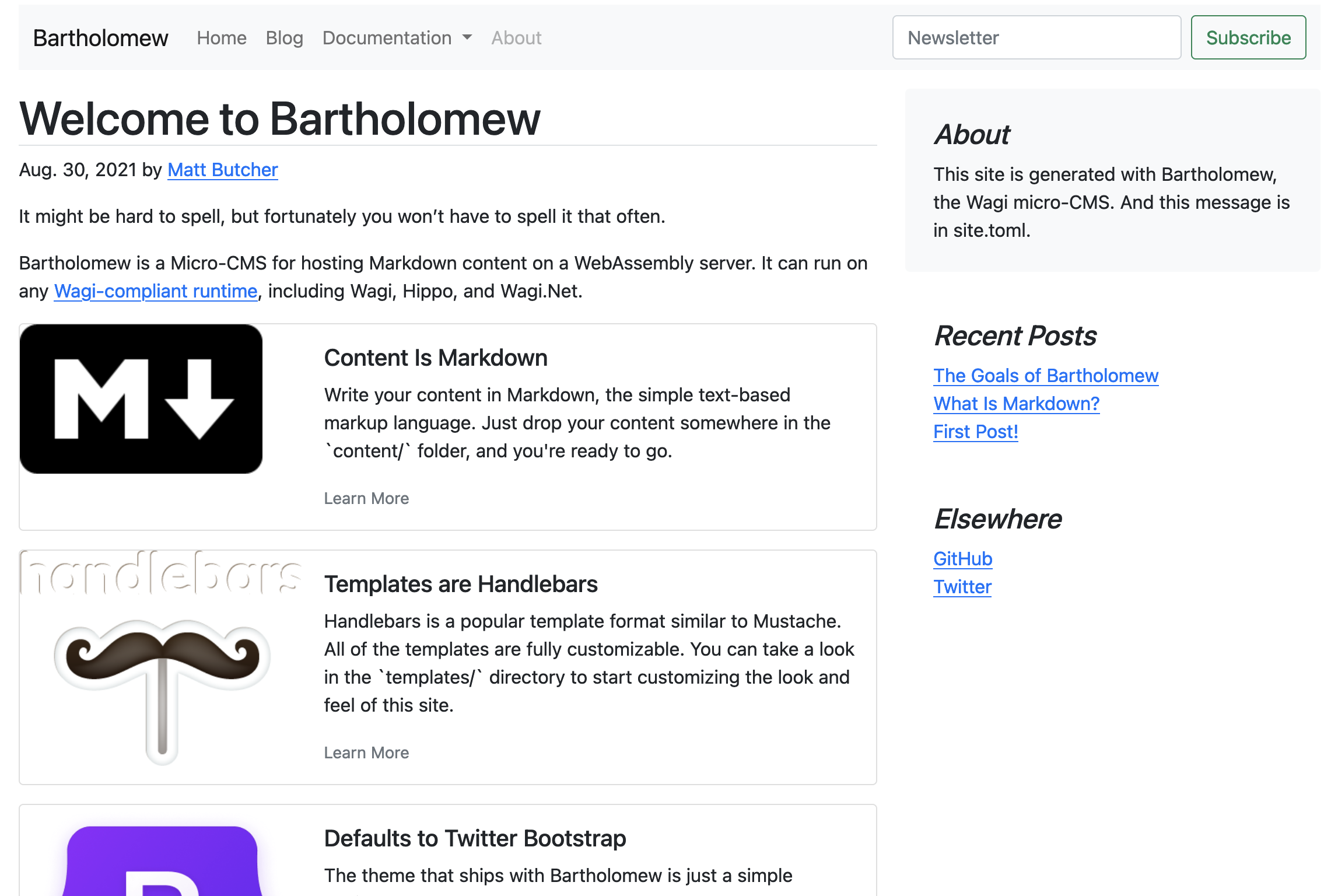Bartholomew is a simple CMS-like tool for hosting a website. It is compiled entirely to WebAssembly, and can run in any Wagi-capable system.
Check out the docs
Currently, the best way to get Bartholomew is to fetch this directory. To build
Bartholomew from source, just run make build, which basically does a
cargo build --target wasm32-wasi --release.
You can also use the pre-built batholomew.wasm or the versioned bindles.
To run Bartholomew, you will need a Wagi-capable runtime.
For example, you can just download a recent release of Wagi and put it on your $PATH.
Then the make serve command can start it all up for you.
With Wagi:
$ wagi -c modules.toml
With Hippo:
$ hippo push
For convenience, make serve builds the code, and then runs wagi -c.
Bartholomew can run inside of any CGI environment that supports directly executing Wasm modules. That basically means Hippo, Wagi, and Wagi.net. (If you get it running in another environment, please tell us!)
Bartholomew requires that several directories are mounted into the Wasm module:
templates/should contain Handlebars templates.content/should contain Markdown files.scripts/contains Rhai scripts that are available as template helpers.config/site.tomlis the main site configuration file
By convention, we suggest putting all of your Wasm modules in a directory called modules/.
However, there is no hard-coded reason why you need to do this.
A modules.toml might look something like this:
[[module]]
module = "target/wasm32-wasi/release/bartholomew.wasm"
route = "/..."
volumes = { "content/" = "content/" , "templates/" = "templates/", "scripts/" = "scripts/", "config/" = "config/"}At the time of this writing, Bartholomew does not serve static files. Instead, use the fileserver for Wagi:
[[module]]
module = "modules/fileserver.gr.wasm"
route = "/static/..."
volumes = { "/" = "static/"}
Using the fileserver has the distinct security advantage that downloadable files are stored in isolation from executed files like templates.
Bartholomew content consists of Markdown documents with TOML headers (aka frontmatter):
title = "This is the title"
description = "A quick description of the article"
[extra]
info = "The [extra] section is for your own custom metadata fields. You can use them in templates."
# The three dashes mark the end of the header and the beginning of the content
---
# Hello
This is the markdown content
Bartholomew supports Markdown via the Pulldown-Cmark library.
Front matter is fairly basic, limited to a few predefined entries, and a map of custom name/value pairs:
title = "The title"
description = "A short description"
template = "main" # The default is `main`, which correlates to `templates/main.hbs`
[extra]
key = "your custom name value pairs go hear, but values MUST be strings"
Markdown support includes all the usual stuff plus fenced codeblocks. Image links are supported, but you need to use the external fileserver library to display the images.
Bartholomew uses a version of the Handlebars template language. The template syntax is describe in the Handlebars documentation.
Every file in the templates/ directory will be compiled to a template. The file is then
accessible by its relative name, minus the extension. For example. templates/main.hbs
will be accessible as main.
Note that Bartholomew expects to find a template named main. This template is used as
a default when the content frontmatter does not contain a template directive. It is also
used when an error occurs. You must have a main template.
Frontmatter is available in the template using the {{ page.frontmatter }} object.
For example, to print the title, use {{ page.frontmatter.title }}. To access your custom
[extra] field named foo, use {{ page.frontmatter.extra.foo }}.
The body is injected to the template converted to HTML. That is, the template does not have access to the Markdown version of the document.
To print the HTML body without having the output escaped, use {{{ page.body }}} (note the
triple curly braces).
